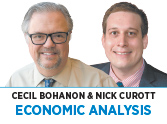Subscriber Benefit
As a subscriber you can listen to articles at work, in the car, or while you work out. Subscribe Now Recently, the Federal Reserve announced a shift to “average inflation targeting.” What is that and why does it matter to us and whoever sits in the Oval Office next January?
Recently, the Federal Reserve announced a shift to “average inflation targeting.” What is that and why does it matter to us and whoever sits in the Oval Office next January?
In 2012, the Fed committed to targeting inflation at 2%. Since then, however, inflation has averaged 1.5%, a full half a percentage point lower than the target. An average inflation target attempts to make up for past misses and signals that the Fed will allow inflation to rise above 2% for some extended time in the future.
In theory, this has some advantages. First, if the public believes the Fed is going to allow inflation to rise, borrowing at today’s rock-bottom interest rates becomes even more attractive than it currently is. Always good to pay back today’s loans in cheaper dollars in the future. This additional borrowing gives the COVID-ravaged economy the boost it desperately needs. And without awkward negative nominal interest rates. Equally important, making up for misses in the inflation target should make the future price level more predictable for investors and households.
The big question is how far back in time the Fed will look to hit an average inflation rate of 2%. Is inflation supposed to average out at 2% over a period of two years, or five, or 10? And how long will the Fed allow itself to take to make up for previous misses? The answer is that no one knows. Chairman Jerome Powell has said, “We are not tying ourselves to a particular mathematical formula that defines the average.” In other words, it’s anyone’s guess.
So, while average inflation targeting has some theoretical advantages, the move is easily seen as nothing more than a fig leaf for the Fed to increase its own discretion. It can allow inflation to run over or under 2% for an indefinite amount of time and claim to be following its policy. But this is, as our British friends say, “too clever by half.” Increased discretion sows seeds of uncertainty that discourage investment not only now but in the future.
It is also unclear whether the Fed will really let inflation run significantly over 2% once the economy recovers. Following through would require providing monetary stimulus after it’s no longer needed, which risks economic overexpansion and distortions in financial markets.
The economy needs bold and predictable monetary policy. What it got is bureaucratic doublespeak. For the Fed, that’s become par for the course.•
__________
Bohanon and Curott are professors of economics at Ball State University. Send comments to [email protected].
Please enable JavaScript to view this content.

The Fed (and the real estate Developer-in-Chief) seem to have no issue with a loose money policy that results in “distortions in financial markets”. It props up the value of highly leveraged assets, increases real estate values, and inflates stock and bond prices.